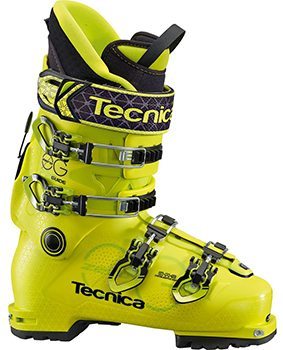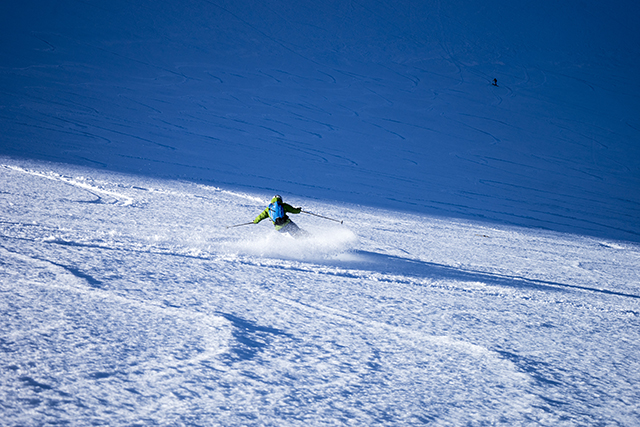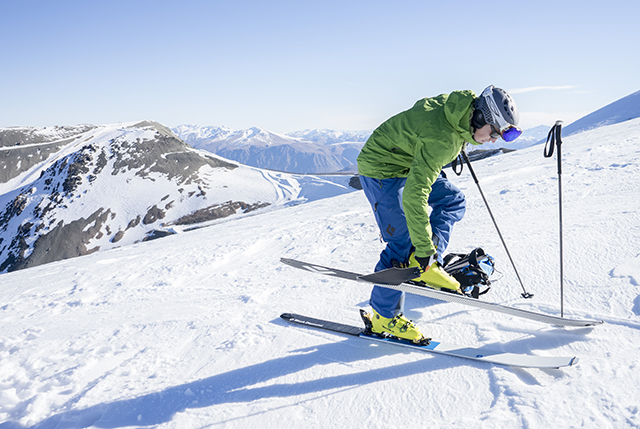
2016-2017 Tecnica Zero G Guide Pro
Size Tested: 27.5
Stated BSL: 315 mm
Stated Range of Motion: 44°
Stated Last: 99 mm
Stated Flex: 130
Stated Weight per Boot (size 26.5) : 1540 g
Blister’s Measured Weight per Boot (size 27.5):
- Shells, no liners: 1335 & 1333 g
- Liners, no footbeds: 220 & 225 g
- Shells + Liners: 1555 & 1558 g
MSRP: $900 USD
Test Location: Porters Ski Area and Craigieburn Valley Ski Area, New Zealand
Days Tested: 7
Introduction
Tecnica’s Zero G line of boots is new this year, and is intended to provide a lighter weight, touring-oriented option for skiers who still want a powerful, 4-buckle boot. They are based on the same shell mold as the all new Cochise, but utilize “Triax 3.0” plastic (which is similar to pebax) to save significant weight.
The Zero G boots are also shipped with a rockered set of sole blocks, rather than the alpine sole blocks that come with the Cochise.
The Zero G Guide Pro is the stiffest boot in the new Zero G line, with a stated flex of 130.

Since this boot is another entry into the increasing competitive class of “~1500 gram touring boot intended to ski like an alpine boot,” we’ll try to address a couple of important comparison questions in this flash review.
Fit
My initial impression is that the internal shell is a little shorter than the last version of the Cochise, and is a little more contoured/roomier around the metatarsal area, laterally and medially. The ankle and heel still feel higher volume than I would like, and the relatively thin liner compounds this for me. The shell does accommodate my relatively high instep quite well. As with the previous Cochise (and most alpine boots) I required a 6th toe punch. As always, our recommendation is that you talk with your bootfitter to see if the Tecnica Zero G is right for your fit.
Walk Mode
The walk mode feels similar to me to the old Cochise, which is to say that it is generally “okay”. The forward ROM is adequate for skinning and booting, but not exceptional for those who might have to deal with long approaches or prefer long strides. The rearward ROM is definitely the limiting factor of this boot, and exhibits the same sensation as my older Cochise models which involved my Achilles’ tendon area constantly bumping into rear portion of the lower shell when extending my ankle. This significantly affects the real, useful ROM of the boot for me to much less than I would have expected from just ranging the walk mode in my hands prior to putting the boot on.

The most pertinent comparison for walk mode I had on this trip to New Zealand is the Salomon MTN Lab boot, which has a shorter, more rockered sole, and significantly better rearward ROM for me.
Downhill Performance
Based on my preliminary time in them, the Zero G Pro Guide 130 skis exceptionally well. The lateral support is excellent and the flex, while not super progressive, is adequate for a full day of inbounds skiing. As always, I dislike the numerical flex rating system because it is so subjective. To make a few quick comparisons (and reserving the right to change my mind after more time in them), I’d say that the Zero G is very close in its flex profile to the 1600 g Salomon MTN Lab. It feels less progressive to me than the new Lange Freetour XT, but it also weighs a bit less than the 1820 g Freetour XT. That means if you’re looking for a boot that sacrifices a lot of touring efficiency for downhill performance the Freetour is the way to go. However, if you’re looking for a boot that skis and walks very well the MTN Lab and Zero G are much better choices.
The most important point I can impart here is that the fit of the boot should be given far more priority when deciding between the excellent boots mentioned above.
So far, I personally have achieved my best fit in the Lange, followed by the Salomon MTN Lab and, lastly, the Tecnica Zero G. Consequently, that would be my rating for ski performance, but I have no doubt that any of these boots will ski exceptionally well if an excellent fit is achieved. So, once again, I am strongly advising that you buy your boots from your most trusted local shop/bootfitter. Any performance differences in the boots themselves will be vastly outweighed by achieving a good fit.
Bottom Line (for now)
If you’re looking for a sub-1600 gram alpine boot that skis and tours well and has the options of replaceable sole blocks, I can’t think of a better choice than the Zero G — if it fits your foot.
If you prioritize tour-ability with shorter, rockered soles and a better walk mode + similar ski performance, my current recommendation is that you should see if the Salomon MTN Lab fits your foot.
Update: You can now read our full review of the Tecnica Zero G Guide Pro

I´m looking forward to put mi fingers to the boot.
One question:
what about the stiffness rearwards.
What happens if someone falls into the back seat and tries to get back?
Thanks
Alex
Thanks for reading AR. The “backseat” support of the Zero G is as good as any touring boot out there and better than most. It’s in the same category as the MTN Lab and better than the Vulcan. I need more time in them but I’d say that in this regard they are very much like an alpine boot.
Paul, thanks so much for the reply – and sorry for my typos, such a shame.
During the last months I tried to gather some info about this boot and the issue with the rear stifness was mentioned both on TGR and hier: https://14erskiers.com/blog/2016/03/review-tecnica-zero-g-guide-boots/
I shall probably decide between MTN Lab and Zero G Pro, as soon as i´ll be able to put a foot into the latter.
Hello! Are you guys at blister going to be getting on the new Cochise 130 DYN boot? Quite interested to hear how that boot performs. Thanks and keep up the good work.
Hi, how does this boot compare to Scarpa Freedom SL? in flex as well as in fit. How does a non “pro” version compare in flex.?
I have Freedom SL and they are a bit stiff + I have problem with hight of instep…
Hi Nekaj, I haven’t skied the Freedom SL yet so it’s tough for me to give you a comparison. I also have only skied then Guide Pro 130. I can say that I also have a relatively high instep and do fine in the Zero G. As always, we recommend that you buy your boots from a local shop to make sure you get the best fit.
Hi from Spain, Paul!!
My question about this boot is concerned to the sole. Is it suitable with the Atomic Tracker WTR binding? (2013/2014 iteration)
Thanks a lot.
Hi Kico, Based on our recent correspondence with Tecnica, you should be fine in any WTR binding if you buy the optional Alpine Sole block kit for the Zero G. You would need an MNC binding if you wanted to stick with the standard soles that come with the boots.
“They are based on the same shell mold as the all new Cochise, but utilize Grilamid plastic to save significant weight.”
I was under the impression this boot was made from Pebax? What Tecnica is calling Triax 3. But heard they were switching to Grilamid for next year…
We just asked Blizzard for clarification, and this was the reply: “The boot was never Pebax. Rather the plastic is called Triax (this is the 3rd iteration), and it’s similar to Pebax. Next year it does change to Grilamid.”
Thanks Jonathan for the reply and clarifying that with Tecnica. Very helpful reviews on the boot, thanks Paul. I guess my question would then be, why the switch to Griliamid? I wonder if this will change weight/performance, flex properties at all… Any thoughts?
Out of curiosity and after seeing the new Tecnica Zero G Tour, have you checked if it would be possible, without re-drilling the boot (e.g. using the same holes present already) , rotate 180 degrees the first buckle?